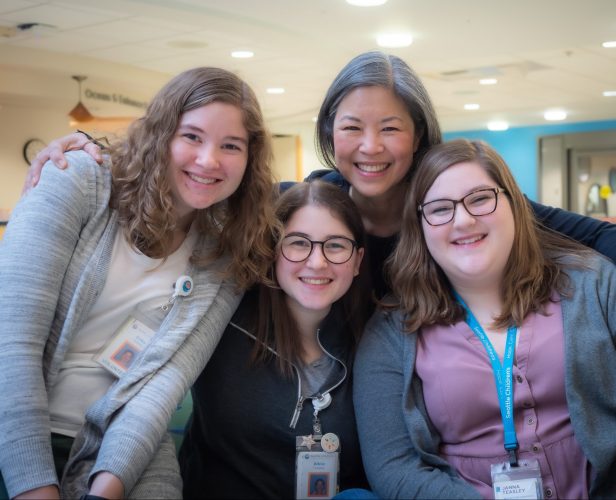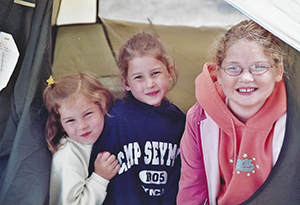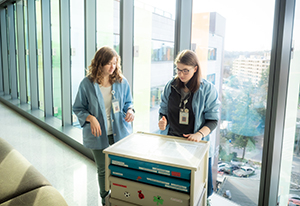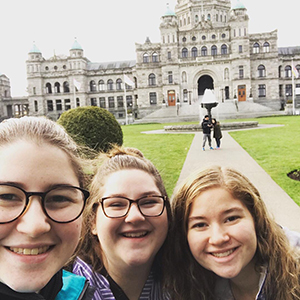
When Ken and Kathi Teasley learned their two oldest daughters were deaf, they feared it would hold them back. Instead, Seattle Children’s providers taught the girls to live without limits and use their experience as people who are deaf and hard of hearing to help others.
Now in their 20s, all three of the Teasley sisters volunteer or work at Seattle Children’s.
Feeling lost
Ken and Kathi began to worry about their daughter Erika’s hearing when she was 9 months old.
Erika was quite perceptive when she could see or feel something, but she didn’t respond when her parents called her name or clapped behind her. She also wasn’t talking or babbling like her peers.
The Teasleys were referred to Seattle Children’s Hearing Loss Clinic where tests revealed Erika had severe hearing loss that would eventually make her deaf. She was ultimately diagnosed with a genetic cause of hearing loss. Her younger sister, Alicia, had the same genetic condition.
“We were shocked,” Ken said. “No one in my family or Kathi’s had a history of hearing impairment. We didn’t know anyone who was deaf, and we didn’t know what to do. We didn’t know how we would communicate with our daughters. We felt lost.”
Seattle Children’s helped the Teasleys find their footing by introducing them to other families with children who are deaf or hard of hearing in a “Birth to Three” group program. They also benefited from working with the Audiology team.
Their perspectives further changed once they met Dr. Kathy Sie, a Seattle Children’s otolaryngologist and now a 28-year surgical veteran who leads the Division of Otolaryngology and the Childhood Communication Center.
“Our parents got a lot of advice from people about everything Alicia and I wouldn’t be able to do because we were deaf,” Erika said. “But Dr. Sie flatly rejected all of that.”
Helping the Teasleys move forward

Once their daughters were diagnosed, Ken and Kathi had many decisions to make about their daughters’ deafness, including whether to get them cochlear implants. At times, they were overwhelmed.
“Most children born with hearing loss are born to parents who are not deaf or hard of hearing,” Sie said. “The parents have to learn to navigate different support services, early intervention services, school services and all kind of accommodations. Ken and Kathi did everything they could to help their daughters communicate — they embraced sign language, technology and therapy.”
Sie worked closely with the Teasleys and guided them through the process of getting Alicia and Erika their cochlear implants in one ear when they were 2 and 3 years old. Later, when they were 10 and 11 years old, they were among the first Seattle Children’s patients to get an implant in their second ear.
“Bilateral implants were a very new concept at the time, and I was nervous about whether it would work,” Erika said. “After two weeks of healing, they turned the implant on for the first time and I thought, ‘Wow, this is so much louder!’ I actually remember going into a hospital bathroom to wash my hands and telling my mom, ‘I can hear the toilet flush!’”
While Erika laughs about that day, Ken gets choked up remembering it.
“I always wanted to fix things for the girls,” Ken said. “I had such a strong desire for the implants to work, even though I knew they might not. Watching the girls react to the stimulation, that was incredible.”
More than medical care
Sie cared for Erika and Alicia until their 21st birthdays, always including them in conversations about their medical care.
“She always treated them like they were the most important people in the room, even when they were just little kids,” Ken said.
Over the years, Sie developed a close connection with the sisters, showing an interest in their lives beyond their immediate medical concerns.
“She had subtle ways of pushing us to be our best, teaching us that being deaf brings a unique perspective that we could use to help others wherever we go in life,” Alicia said.
Giving back

After spending much of their childhoods at the hospital, Erika and Alicia started volunteering at Seattle Children’s as teenagers. Since 2010, they’ve served as messengers, running errands for various departments. They still meet every Friday to clean and stock legacy carts — rolling craft kits that families use to make keepsakes with their child while preparing for end of life.
“Seattle Children’s has given us so much,” Erika said. “It feels good to help families create remembrances that mean the world to them.”
As soon as she was old enough, Janna, the Teasleys’ third and youngest daughter, was eager to join in. She has volunteered and worked at Seattle Children’s hospital gift shop for five years.
“As a kid, I tagged along to all the appointments, and Seattle Children’s staff members always made me feel included,” Janna said.
The sisters have given more than 2,200 hours volunteering for Seattle Children’s.
“I think every time you come in to volunteer, every hour really counts and really helps the hospital as a whole,” Erika said. “It’s shown me that the small things I pick up as a volunteer are helpful to other aspects of my life too. I’ve applied skills I’ve learned volunteering to my workplace and even my personal life.”
A key in their success

Aside from volunteering at Seattle Children’s, the Teasley sisters are also helping others in their professions.
Erika is currently a master specialist in the Disability and Leave Services group at Amazon, working with employees with disabilities to ensure they are successful in their careers.
Alicia is a pediatric mental health specialist in Seattle Children’s Psychiatry and Behavioral Medicine Unit working with kids who are dealing with mental health crises.
Sie is not surprised by how the sisters turned out — she remembers them being bright and inquisitive children. She credits their parents, who always involved their daughters in conversations about their medical care and encouraged them to ask questions.
“Alicia was always right by my side while I examined Erika, wanting to know what was going on,” she said. “She was really motivated to understand medical things, so it’s wonderful to see the direction her career is going. It’s amazing to see that Erika has become such a strong young woman and advocate, and I am so impressed that ‘baby Janna’ has become part of the Children’s community.”
The sisters say Sie’s encouragement helped them succeed.
“It’s because of her that we are able to do these things,” Erika said.

